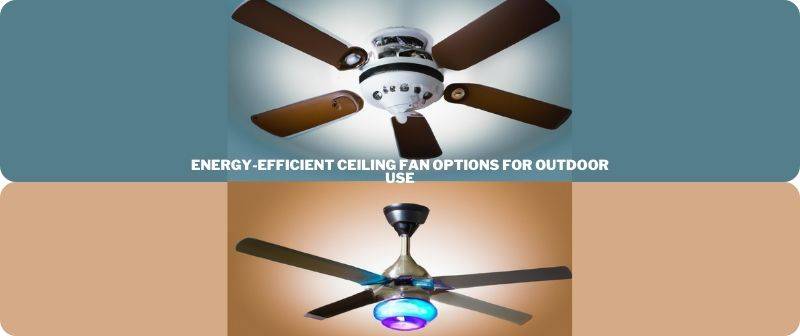As summer approaches and the temperatures start to rise, many of us begin to think about ways to keep our outdoor spaces cool and comfortable. One popular solution is the use of outdoor ceiling fans.
But with so many options on the market, it can be difficult to know which ones are truly energy-efficient.
In this blog post, we’ll dive into the world of outdoor ceiling fans and explore the options available for those looking for an energy-efficient fan solution to beat the heat.
From damp-rated fans to ENERGY STAR-certified models, we’ll cover it all and help you make an informed decision on the perfect fan for your outdoor space. So, let’s get started and find out if there are truly energy-efficient options for outdoor ceiling fans!
Types of Energy-Efficient Ceiling Fans for Outdoor Use

Damp-rated fans
Damp-rated fans are designed to withstand outdoor conditions such as moisture and humidity. They are safe for use in covered patios and sunrooms, making them a great option for energy-efficient outdoor cooling.
These fans typically have weather-resistant materials and finishes and are ETL certified for safety and performance.
Weather-resistant fans
Weather-resistant fans, also known as outdoor fans, are designed to withstand various weather conditions and provide optimal airflow in outdoor spaces.
These fans are made with durable materials such as stainless steel and aluminum to withstand moisture, heat, and sunlight.
Additionally, they often come with weather-resistant blades and sealed motors to protect against water damage.
When looking for an energy-efficient option for your outdoor space, consider a weather-resistant fan that is also rated by Energy Star for maximum energy savings.
Solar-powered fans
Solar-powered fans are an energy-efficient option for outdoor use as they harness the power of the sun to operate.
These fans are equipped with solar panels that convert sunlight into electricity, eliminating the need for traditional electrical sources.
They are suitable for areas where electricity is not readily available or for those looking to reduce their carbon footprint. They are also a cost-effective option as they do not require any additional energy costs.
SEE also Box Fan vs. Tower Fan According to a Reddit user
Features of Energy-Efficient Ceiling Fans for Outdoor Use
Motor
The motor of a ceiling fan plays a crucial role in determining its energy efficiency. Energy-efficient outdoor ceiling fans typically feature DC motors, which consume less power and generate more torque than traditional AC motors.
These types of motors are also known for their virtually silent operation, making them ideal for outdoor spaces where noise pollution can be an issue.
LED lights and other additional features
LED lights and other additional features also contribute to a fan’s energy efficiency. Many outdoor ceiling fans now come equipped with LED lights, which use significantly less energy than traditional incandescent bulbs. These lights not only add aesthetic value to the fan, but they also help to further reduce energy consumption.
Energy Star rating
An Energy Star rating is another important factor to consider when looking for an energy-efficient outdoor ceiling fan.
This rating is given to products that meet certain energy efficiency standards set by the U.S. Environmental Protection Agency. Choosing a fan with an Energy Star rating ensures that it will consume less energy and save you money on your electricity bills in the long run.
Comparison of Energy-Efficient Outdoor Ceiling Fans to Other Cooling Methods
Energy efficiency and cost savings
Energy efficiency and cost savings are two critical factors to consider when selecting a ceiling fan for outdoor use. A fan that is energy efficient will not only save you money on your energy bills, but it will also be better for the environment. An Energy Star rating is a great indicator of a fan’s energy efficiency and can help you make a more informed decision.
Airflow and CFM
Airflow and CFM (cubic feet per minute) are also crucial considerations for outdoor fans. A fan with a higher CFM will circulate more air and provide better cooling, but it may also use more energy.
It’s essential to find the right balance between airflow and energy efficiency to ensure that you are getting the best performance for your money.
Pros and cons of different cooling methods
There are several different cooling methods available for outdoor use, each with its own pros and cons. A traditional fan is a cost-effective option, but it may not be as efficient as other methods.
A misting fan, for example, uses water to cool the air, making it more comfortable in hot weather.
However, it can be more expensive to install and maintain than other options. An evaporative cooler, on the other hand, uses water to cool the air, but it also requires a water source and can be less efficient in dry climates.
Ultimately, the best cooling method for your outdoor space will depend on your budget, climate, and personal preferences.
Conclusion
It is clear that there are indeed energy-efficient options available for outdoor ceiling fans. When considering purchasing an outdoor ceiling fan, it is important to take into account the motor, LED lights, and other additional features, as well as the Energy Star rating.
These factors can greatly impact the energy efficiency and cost savings of the fan. Additionally, considering the airflow and CFM of the fan can ensure that it is properly circulating the air in your outdoor space.
It is also important to weigh the pros and cons of different cooling methods to determine which is the best fit for your specific needs and preferences.
Overall, investing in an energy-efficient outdoor ceiling fan can lead to long-term savings and a more environmentally conscious decision.
How do I know if a ceiling fan is rated for outdoor use?
When purchasing an outdoor ceiling fan, make sure that it is designed for outdoor use. One way is to look for a fan that has been certified by a respected body, such as UL (Underwriters Laboratories) or ETL (Electronic Testing Laboratories) (Intertek Testing Services).
These certificates show that the fan has been tested and authorized for use in outdoor areas and that it can survive factors like rain, wind, and extreme temperatures.
Look for a fan that is labeled “damp-rated” or “wet-rated,” which indicates that it is acceptable for use in damp or humid situations, such as a covered porch or sunroom.
Another technique to determine whether a ceiling fan is suitable for outdoor use is to look at the manufacturer’s specifications. This will enable you to see if it is specifically built for outdoor use.
Can an energy-efficient ceiling fan be used in a covered outdoor area?
When choosing an energy-efficient ceiling fan for a covered outdoor space, it is essential to evaluate the fan’s rating. Not all fans are appropriate for outdoor use because they may not be able to survive the weather.
However, there are numerous energy-efficient products that are intended primarily for outside use and will function well in covered locations. Typically, these fans include weather-resistant coatings and materials, as well as motors and blades that are specifically built to survive the environment.
In addition, these fans may include LED lights that are suitable for outdoor use. Check the fan’s rating and study the manufacturer’s specs to confirm that your energy-efficient ceiling fan is acceptable for use in a covered outdoor space.
Can an energy-efficient ceiling fan help lower my cooling costs in an outdoor area?
An energy-efficient ceiling fan can certainly help lower cooling costs in an outdoor area. This is because an energy-efficient fan uses less energy to operate, which in turn reduces the amount of energy needed to ventilate the space.
Additionally, an energy-efficient fan is designed to provide optimal airflow and CFM, which can be used to circulate cool air throughout the space, thereby minimizing the need for additional cooling methods such as air conditioning.
The use of LED lights and other additional features can also help to enhance the energy efficiency of an outdoor ceiling fan. This will make it even more effective at reducing energy costs.
Overall, investing in an energy-efficient ceiling fan for outdoor use is a smart choice for anyone looking to save money on cooling costs while also reducing their environmental impact.
How do I properly maintain and clean an energy-efficient outdoor ceiling fan?
It is essential to maintain and clean an energy-efficient outdoor ceiling fan in order to ensure its durability and continuing energy efficiency.
The weather resistance of the fan itself is an imperative factor to consider, as some models may be better suited to harsh outside situations than others.
Inspecting the fan’s blades for damage or debris buildup on a regular basis is also a necessity, as this can significantly affect airflow and overall performance. In addition, it is advised to wipe the blades with a damp cloth or mild detergent to eliminate any dirt or dust that may have accumulated.
To guarantee smooth performance, it is also essential to frequently inspect and oil any moving elements, such as the motor and bearings.
Overall, taking the effort to properly maintain and clean an energy-efficient outdoor ceiling fan can significantly increase its longevity and save money on energy bills over time.
- 25 Easy Crafts to Make and Sell Fast for Profit at Home - June 21, 2025
- 16 Essential Fall Maintenance Tasks to Prep Your Home for Winter - June 17, 2025
- Summer Home Prep: What to Fix and Clean Before the Heat Hits - June 14, 2025

